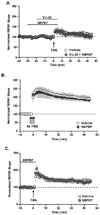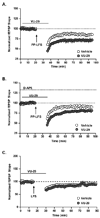mGluR5 positive allosteric modulators facilitate both hippocampal LTP and LTD and enhance spatial learning
- PMID: 19295507
- PMCID: PMC2884290
- DOI: 10.1038/npp.2009.30
mGluR5 positive allosteric modulators facilitate both hippocampal LTP and LTD and enhance spatial learning
Abstract
Highly selective positive allosteric modulators (PAMs) of metabotropic glutamate receptor subtype 5 (mGluR5) have emerged as a potential approach to treat positive symptoms associated with schizophrenia. mGluR5 plays an important role in both long-term potentiation (LTP) and long-term depression (LTD), suggesting that mGluR5 PAMs may also have utility in improving impaired cognitive function. However, if mGluR5 PAMs shift the balance of LTP and LTD or induce a state in which afferent activity induces lasting changes in synaptic function that are not appropriate for a given pattern of activity, this could disrupt rather than enhance cognitive function. We determined the effect of selective mGluR5 PAMs on the induction of LTP and LTD at the Schaffer collateral-CA1 synapse in the hippocampus. mGluR5-selective PAMs significantly enhanced threshold theta-burst stimulation (TBS)-induced LTP. In addition, mGluR5 PAMs enhanced both DHPG-induced LTD and LTD induced by the delivery of paired-pulse low-frequency stimulation. Selective potentiation of mGluR5 had no effect on LTP induced by suprathreshold TBS or saturated LTP. The finding that potentiation of mGluR5-mediated responses to stimulation of glutamatergic afferents enhances both LTP and LTD and supports the hypothesis that the activation of mGluR5 by endogenous glutamate contributes to both forms of plasticity. Furthermore, two systemically active mGluR5 PAMs enhanced performance in the Morris water maze, a measure of hippocampus-dependent spatial learning. Discovery of small molecules that enhance both LTP and LTD in an activity-appropriate manner shows a unique action on synaptic plasticity that may provide a novel approach for the treatment of impaired cognitive function.
Figures








References
-
- Andreasen NC. Schizophrenia: the fundamental questions. Brain Res Brain Res Rev. 2000;31:106–112. - PubMed
-
- Balschun D, Zuschratter W, Wetzel W. Allosteric enhancement of metabotropic glutamate receptor 5 function promotes spatial memory. Neuroscience. 2006;142:691–702. - PubMed
-
- Bear MF, Huber KM, Warren ST. The mGluR theory of fragile X mental retardation. Trends Neurosci. 2004;27:370–377. - PubMed
Publication types
MeSH terms
Substances
Grants and funding
LinkOut - more resources
Full Text Sources
Other Literature Sources
Miscellaneous

